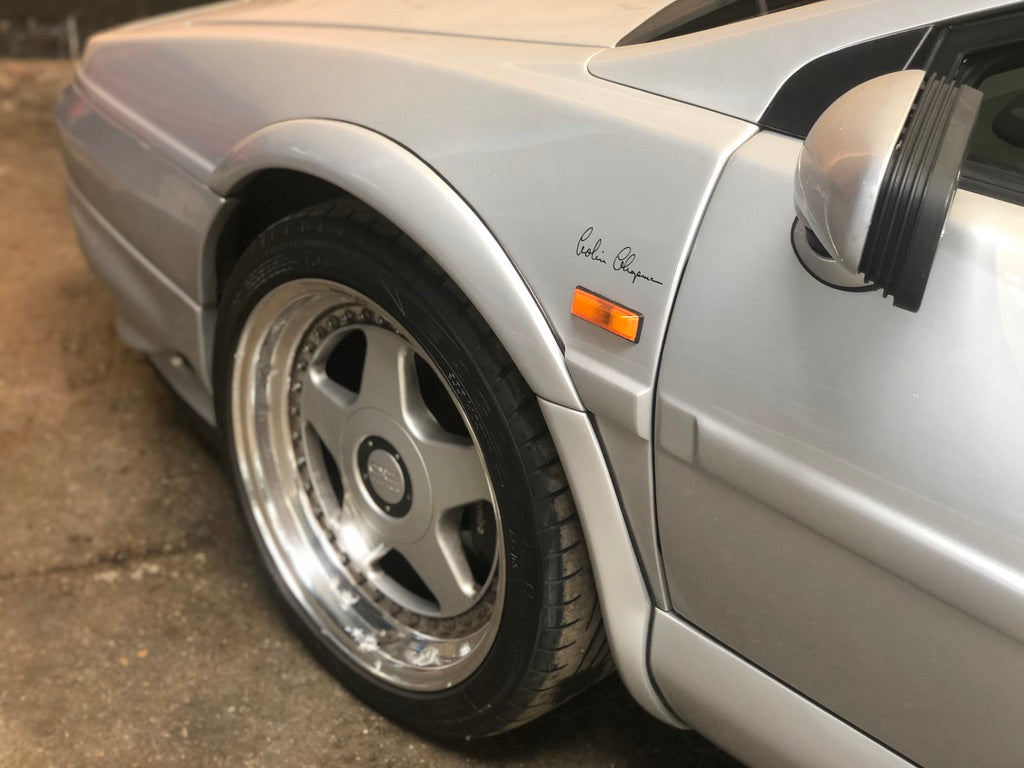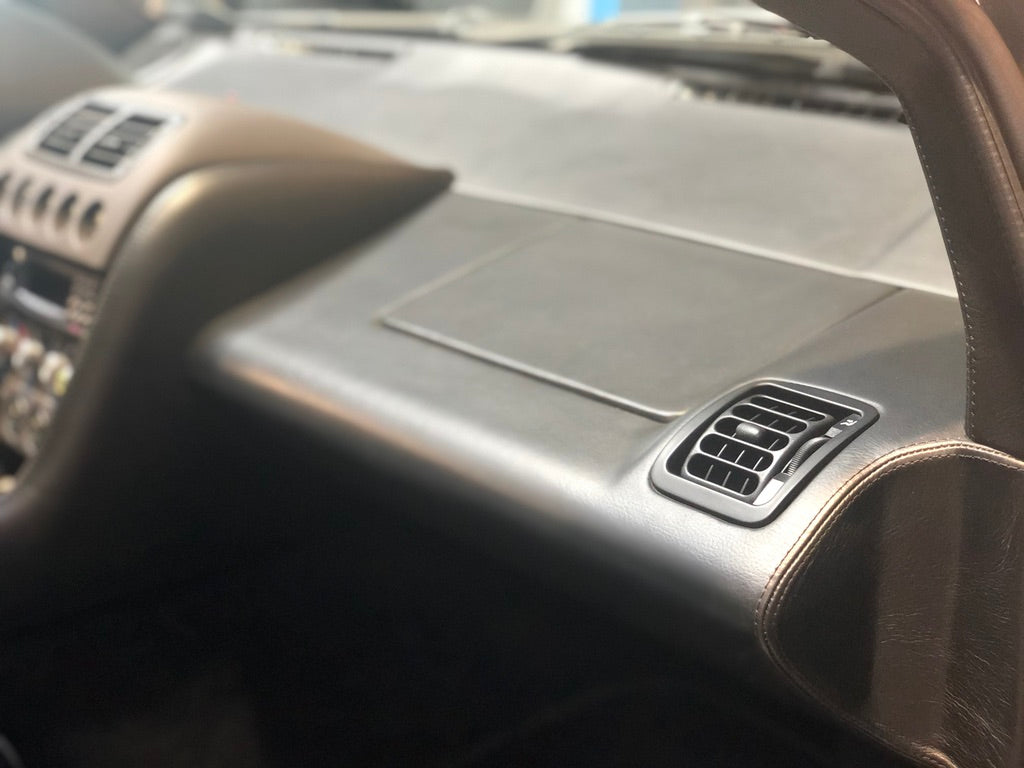














































Lotus Esprit V8 BI-TURBO
1998 / 73 800 km

Specifications
Lotus
Esprit
1998
20
3.506
Propulsion
Non
73 800 km
Black
Silver
Essence
Manuelle
Historique
From its launch, the Lotus Esprit stood out with its very flat and sharp design lines by Giorgietto Giugiaro, who was then in the midst of Edge Design. In 1987, Peter Stevens (author of the Jaguar XR15 and the McLaren F1) was tasked with reviewing and updating the line of the Ketteringham Hall GT. The front and rear bumpers were redesigned and now seemed to be completely integrated into the line, the black plastic had disappeared and the rear lights were modernized. More rounded, especially at the front, the bumpers seemed to outrageously lengthen the Lotus Esprit, while the first generation was distinguished by particularly very contained overhangs. To this exceptional silhouette, the Esprit added a cozy interior, a cocoon where leather breathes and a flattering English presentation.
The Spirit also follows rules dear to Colin Chapman, a contained weight and exceptional behavior.
All that was missing was a noble engine, on a par with the world of great British GTs to which this Esprit belongs. This gap was filled in 1996, while remaining faithful to the brand's DNA. The British engineers therefore designed and developed a V8 in just 27 months with the measured dimensions: 220 kg dry with all the peripherals (i.e. only 40 kg more than the four-cylinder) and extremely compact dimensions.
With a displacement of 3.5 litres, this V8 with its advanced distribution develops 350 hp at 6500 rpm and 400 Nm of torque at 4250 rpm. To achieve this, two Garret T25 turbochargers blowing at 0.75 bars are responsible for administering all its vigour to the V8. The turbos are water-cooled but do not have exchangers. To optimise the operation of the turbochargers, Lotus engineers have designed a specific crankshaft. Usually, in the bowels of a V8 there is a cross-shaped crankshaft. But in the case of the Lotus Esprit V8, it is "flat", which allows for explosion moments at regular intervals (in degrees of rotation) on each cylinder. The flow of exhaust gases is more homogeneous.
Since we are dealing with the top version of the Lotus Esprit, a generously sized spoiler is fitted to the rear and hinders access to the trunk, since it is fixed. Wide 17-inch magnesium rims at the front and 18-inch at the rear are fitted, filling the wheel arches perfectly. Thus fitted, the Lotus platform seems to spread out its entire width on the asphalt. Very low (1.150 meters!) and very wide, the Lotus Esprit V8 remains today an extraordinary GT that all passers-by turn around to look at. The side skirts incorporate air intakes to cool the V8 lurking behind the occupants' backs.
In January 1998, the interior was modernized, abandoning the traditional "boomerang" dashboard for a smaller, rounded panel that lost the oil temperature and turbo gauges. The center console was also modified, with the control buttons coming from... the Peugeot 205. The technical modifications of this Lotus Esprit V8 "phase II" are as follows: new twin-plate clutch (instead of the single-plate), more rigid steel clutch housing (and no longer aluminum), modified starter motor location, new aluminum rims, rear spoiler with modified attachments (it is fixed with the engine hood), new generation ABS, less prominent central tunnel.
The Lotus Esprit V8 Turbo is without a doubt the most desirable and accomplished version of the species. But it is also the rarest, 1,237 examples left the factory, right and left hand drive combined.
Our example is therefore a rare phase II and has only had two owners, both French.
- April 17, 1998: Vehicle put into service by Lotus Cars LTD., parent company
- August 18, 1998: Sale of the vehicle in France to its first owner
- May 25, 1999: Annual maintenance carried out by Sport et Prestige Services (94) at 1,240 km
- xx March 2003: Annual maintenance by Lotus Ostend (Belgium) at 8,840km
- xx April 2005: Annual maintenance by Lotus Ostende at 17,900km
- February 8, 2007: Annual maintenance by Lotus Ostend at 28,038km
- August 29, 2008: Annual maintenance by Lotus Ostend at 41,322km
- February 21, 2009: Annual maintenance by Lotus Ostend at 43,924km
- August 22, 2013: Annual maintenance by Lotus Ostend at 50,470km
- February 10, 2017: Technical inspection at 63,245 km
- July 28, 2017: Replacement of front discs and pads, replacement of rear pads and bleeding of the brake circuit at 66,151 km
- November 8, 2018: Annual interview
- March 1, 2019: Replacement of the two rear tires and technical inspection at 69,408 km
- March 26, 2020: Annual maintenance at 70,200 km including replacement of the two turbos, replacement of the timing belts, replacement of the accessory belt and gearbox oil change.
From its launch, the Lotus Esprit stood out with its very flat and sharp design lines by Giorgietto Giugiaro, who was then in the midst of Edge Design. In 1987, Peter Stevens (author of the Jaguar XR15 and the McLaren F1) was tasked with reviewing and updating the line of the Ketteringham Hall GT. The front and rear bumpers were redesigned and now seemed to be completely integrated into the line, the black plastic had disappeared and the rear lights were modernized. More rounded, especially at the front, the bumpers seemed to outrageously lengthen the Lotus Esprit, while the first generation was distinguished by particularly very contained overhangs. To this exceptional silhouette, the Esprit added a cozy interior, a cocoon where leather breathes and a flattering English presentation.
The Spirit also follows rules dear to Colin Chapman, a contained weight and exceptional behavior.
All that was missing was a noble engine, on a par with the world of great British GTs to which this Esprit belongs. This gap was filled in 1996, while remaining faithful to the brand's DNA. The British engineers therefore designed and developed a V8 in just 27 months with the measured dimensions: 220 kg dry with all the peripherals (i.e. only 40 kg more than the four-cylinder) and extremely compact dimensions.
With a displacement of 3.5 litres, this V8 with its advanced distribution develops 350 hp at 6500 rpm and 400 Nm of torque at 4250 rpm. To achieve this, two Garret T25 turbochargers blowing at 0.75 bars are responsible for administering all its vigour to the V8. The turbos are water-cooled but do not have exchangers. To optimise the operation of the turbochargers, Lotus engineers have designed a specific crankshaft. Usually, in the bowels of a V8 there is a cross-shaped crankshaft. But in the case of the Lotus Esprit V8, it is "flat", which allows for explosion moments at regular intervals (in degrees of rotation) on each cylinder. The flow of exhaust gases is more homogeneous.
Since we are dealing with the top version of the Lotus Esprit, a generously sized spoiler is fitted to the rear and hinders access to the trunk, since it is fixed. Wide 17-inch magnesium rims at the front and 18-inch at the rear are fitted, filling the wheel arches perfectly. Thus fitted, the Lotus platform seems to spread out its entire width on the asphalt. Very low (1.150 meters!) and very wide, the Lotus Esprit V8 remains today an extraordinary GT that all passers-by turn around to look at. The side skirts incorporate air intakes to cool the V8 lurking behind the occupants' backs.
In January 1998, the interior was modernized, abandoning the traditional "boomerang" dashboard for a smaller, rounded panel that lost the oil temperature and turbo gauges. The center console was also modified, with the control buttons coming from... the Peugeot 205. The technical modifications of this Lotus Esprit V8 "phase II" are as follows: new twin-plate clutch (instead of the single-plate), more rigid steel clutch housing (and no longer aluminum), modified starter motor location, new aluminum rims, rear spoiler with modified attachments (it is fixed with the engine hood), new generation ABS, less prominent central tunnel.
The Lotus Esprit V8 Turbo is without a doubt the most desirable and accomplished version of the species. But it is also the rarest, 1,237 examples left the factory, right and left hand drive combined.
Our example is therefore a rare phase II and has only had two owners, both French.
- April 17, 1998: Vehicle put into service by Lotus Cars LTD., parent company
- August 18, 1998: Sale of the vehicle in France to its first owner
- May 25, 1999: Annual maintenance carried out by Sport et Prestige Services (94) at 1,240 km
- xx March 2003: Annual maintenance by Lotus Ostend (Belgium) at 8,840km
- xx April 2005: Annual maintenance by Lotus Ostende at 17,900km
- February 8, 2007: Annual maintenance by Lotus Ostend at 28,038km
- August 29, 2008: Annual maintenance by Lotus Ostend at 41,322km
- February 21, 2009: Annual maintenance by Lotus Ostend at 43,924km
- August 22, 2013: Annual maintenance by Lotus Ostend at 50,470km
- February 10, 2017: Technical inspection at 63,245 km
- July 28, 2017: Replacement of front discs and pads, replacement of rear pads and bleeding of the brake circuit at 66,151 km
- November 8, 2018: Annual interview
- March 1, 2019: Replacement of the two rear tires and technical inspection at 69,408 km
- March 26, 2020: Annual maintenance at 70,200 km including replacement of the two turbos, replacement of the timing belts, replacement of the accessory belt and gearbox oil change.